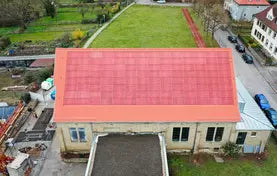https://solarquarter.com/2023/03/24/pusan-national-university-researchers-reveal-the-mechanism-of-oxygen-transport-kinetics-in-perovskite-oxides/
Pusan National University Researchers Reveal the Mechanism of Oxygen Transport Kinetics in Perovskite Oxides
Atomistic understanding of oxygen diffusion in perovskite oxides paves the way towards development of more efficient solid oxide fuel cells.
Fast, reversible oxygen transport with minimal volume change is a key requirement for energy-efficient solid oxide fuel cells (SOFCs). Perovskite oxides are ideal candidates to host this phenomenon through topotactic phase transition. However, the exact mechanism of oxygen diffusion during topotactic phase transition in these substances remained hitherto unknown. Now, however, researchers have directly visualized this phenomenon at the atomic scale, a remarkable milestone towards realizing better SOFCs.
Perovskite oxides show great potential for use in energy storage applications. Topotactic phase transition of these materials enable fast, reversible oxygen transport with minimal volume change, a critical requirement for solid oxide fuel cells (SOFCs). However, a lack of direct atomic-scale observations of this phenomenon limits our understanding of how oxygen diffusion occurs during topotactic phase transition of perovskite oxides. “Understanding the atomic-scale mechanism of oxygen diffusion through a crystalline oxide lattice is crucial for the development of efficient electrodes and electrolytes for energy- and cost-effective, low-temperature SOFCs”, explains Dr. Jaekwang Lee, Associate Professor in the Department of Physics at Pusan National University (PNU), Korea, who has been researching materials and their design for energy applications. To this end, a team of researchers led by Dr. Lee has combined live, high-resolution atomic-scale imaging with density functional theory (DFT) calculations to decode the underlying mechanism of oxygen diffusion in perovskite oxides.
In an article published in Matter, the researchers revealed an active oxygen-diffusion mechanism leading to the topotactic transition of strontium iron oxides from perovskite (SrFeO3, or PV-SFO) to brownmillerite (SrFeO2.5, or BM-SFO) at a relative low temperature. They demonstrated direct atomic-scale imaging of this phenomenon and unveiled the emergence of hyper-stoichiometric BM-SFO with excess oxygen at the phase boundary of the material. Further, using first principles density functional theory (DFT) modelling, the team confirm that rapid oxygen diffusion takes place along dioxido(dioxo)iron (FeO4) chains via sequential modification of two iron oxides with different number of oxygen atoms. The researchers established that the flexibility of multivalent iron ions (i.e., Fe4+ and Fe5+) and rigidity of the strontium lattice are the key factors that accommodate excess oxygen during phase transition. Finally, they ascertained that the steady-state oxygen diffusion across fast diffusion channels is “interstitial” in nature, wherein the oxygen atom goes in between other atoms in the crystal structure.
A complete understanding of how oxygen diffuses through the crystalline lattice of an electrolyte or electrode is extremely useful for energy and device applications. The insight gained by the live high-resolution atomic-scale imaging provides a foundation for manipulating oxygen transport kinetics in energy storage devices. “Our study could contribute to long-term research on developing perovskite-based electrolyte materials for low-temperature SOFCs, hence helping the optimization of strategies for energy storage applications”, notes Dr. Lee.
In summary, this discovery lays the foundation improving the oxygen exchange rate and cyclic operation performance to develop energy efficient SOFCs.








